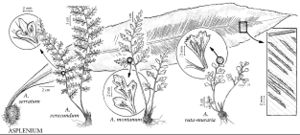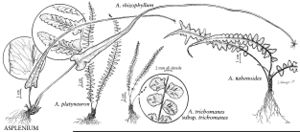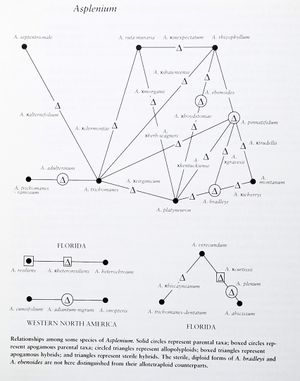Difference between revisions of "Aspleniaceae"
FNA>Volume Importer |
FNA>Volume Importer |
||
| Line 24: | Line 24: | ||
--><p>Genera 1, species ca. 700 (1 genus, 28 species, and 3 nothospecies in the flora).</p> | --><p>Genera 1, species ca. 700 (1 genus, 28 species, and 3 nothospecies in the flora).</p> | ||
|tables= | |tables= | ||
| − | |references= | + | |references={{Treatment/Reference |
| + | |id=gastony1986a | ||
| + | |text=Gastony, G. J. 1986. Electrophoretic evidence for the origin of a fern species by unreduced spores. Amer. J. Bot. 73: 1563--1569. | ||
| + | }}{{Treatment/Reference | ||
| + | |id=kramer1990a | ||
| + | |text=Kramer, K. U. and R. Viane. 1990. Aspleniaceae. In: K. Kubitzki et al., eds. 1990+. The Families and Genera of Vascular Plants. 1+ vol. Berlin etc. Vol. 1, pp. 52--56. | ||
| + | }}{{Treatment/Reference | ||
| + | |id=reichstein1981a | ||
| + | |text=Reichstein, T. 1981. Hybrids in European Aspleniaceae (Pteridophyta). Bot. Helv. 91: 89--139. | ||
| + | }} | ||
}}<!-- | }}<!-- | ||
| Line 41: | Line 50: | ||
|illustration copyright=Flora of North America Association | |illustration copyright=Flora of North America Association | ||
|distribution=Worldwide. | |distribution=Worldwide. | ||
| − | |reference= | + | |reference=gastony1986a;kramer1990a;reichstein1981a |
|publication title= | |publication title= | ||
|publication year= | |publication year= | ||
|special status= | |special status= | ||
| − | |source xml=https://jpend@bitbucket.org/aafc-mbb/fna-data-curation.git/src/ | + | |source xml=https://jpend@bitbucket.org/aafc-mbb/fna-data-curation.git/src/f50eec43f223ca0e34566be0b046453a0960e173/coarse_grained_fna_xml/V2/V2_139.xml |
}}<!-- | }}<!-- | ||
-->[[Category:Treatment]] | -->[[Category:Treatment]] | ||
Revision as of 20:48, 16 December 2019
Plants terrestrial, on rock, or rarely epiphytic. Stems erect or nearly erect, rarely long-creeping, scaly. Steles radially symmetric or dorsiventral (with structurally distinct abaxial and adaxial aspects) dictyosteles. Leaves monomorphic, rarely almost dimorphic with fertile leaves taller and more erect than sterile ones. Petioles with 1 vascular bundle X-shaped in cross section or with 2 vascular bundles back to back and C-shaped. Blades extremely diverse, simple to 4-pinnate, commonly with tiny glandular hairs and a few linear scales, rarely with spreading hairs. Veins free to anastomosing. Sori borne on veins, ± lunate to linear. Indusia usually present, shape conforming to sorus and originating along 1 side of sorus. Sporangia with stalk of 1 row of cells, annulus vertical, interrupted by sporangial stalk. Spores monolete; perispore typically winged, spiny, reticulate, or perforate. Gametophytes surficial, green, cordate.
Distribution
Worldwide.
Discussion
Members of this family can usually be identified by the combination of clathrate stem scales and indusiate linear sori. Supporting anatomic characteristics include the two vascular bundles in the petiole that unite distally in the petiole to form an X-shaped petiolar strand, and the single row of cells in the sporangial stalk. The scales consist of cells with dark, thick, radial walls and clear, thin, tangential walls, giving the scales a clathrate (latticelike) appearance reminiscent of lead moldings between plates of stained glass.
As construed here, Aspleniaceae comprise a single, huge, extremely diverse genus, Asplenium. A satisfactory taxonomic division into subgenera or satellite genera has not been possible because of the absence of any significant gaps. Various segregates have been proposed (e.g., Camptosorus, Phyllitis, Ceterach, Pleurosorus), but numerous "intergeneric" hybrids occur.
The members of Asplenium are popular with plant evolutionists, field naturalists, and fern gardeners, not only because of the interesting morphology of the plants but also because of their remarkable ability to form spectacular hybrids, often combining dramatically different leaf shapes. In North America, 23 diploid hybrids and allopolyploids have been recorded. At least two of these hybrid combinations occur as both sterile diploids and their fertile allotetraploid derivatives. Only those hybrids that are reproductively competent (through vigorous clone-forming by root proliferations or apogamy, or rarely through sexual reproduction) are treated in the key and fully described below.
Only about two-fifths of the reproductively competent species are believed to be cladistically divergent species; the other three-fifths are of hybrid origin (allopolyploids). For two of the allotetraploids, sterile diploids of the same parentage are also known. The most unusual allopolyploid phytogeographically is Asplenium adiantum-nigrum, the parents of which are known only in the Old World. These reticulate relationships are summarized in the reticulogram.
Polyploidy is widespread in Asplenium, and the chromosome numbers vary from 2 x to 6 x. Two species, Asplenium trichomanes and A. heterochroum, occur in different levels of polyploidy—2 x and 4 x, and 4 x and 6 x, respectively. The highest chromosome number known for Asplenium in North America is 2n = 216 (in A. trichomanes-dentatum and the hexaploid form of A. heterochroum). The only three apogamous taxa are A. monanthes (3 x), A. resiliens (3 x), and A. × heteroresiliens (5 x).
Genera 1, species ca. 700 (1 genus, 28 species, and 3 nothospecies in the flora).


